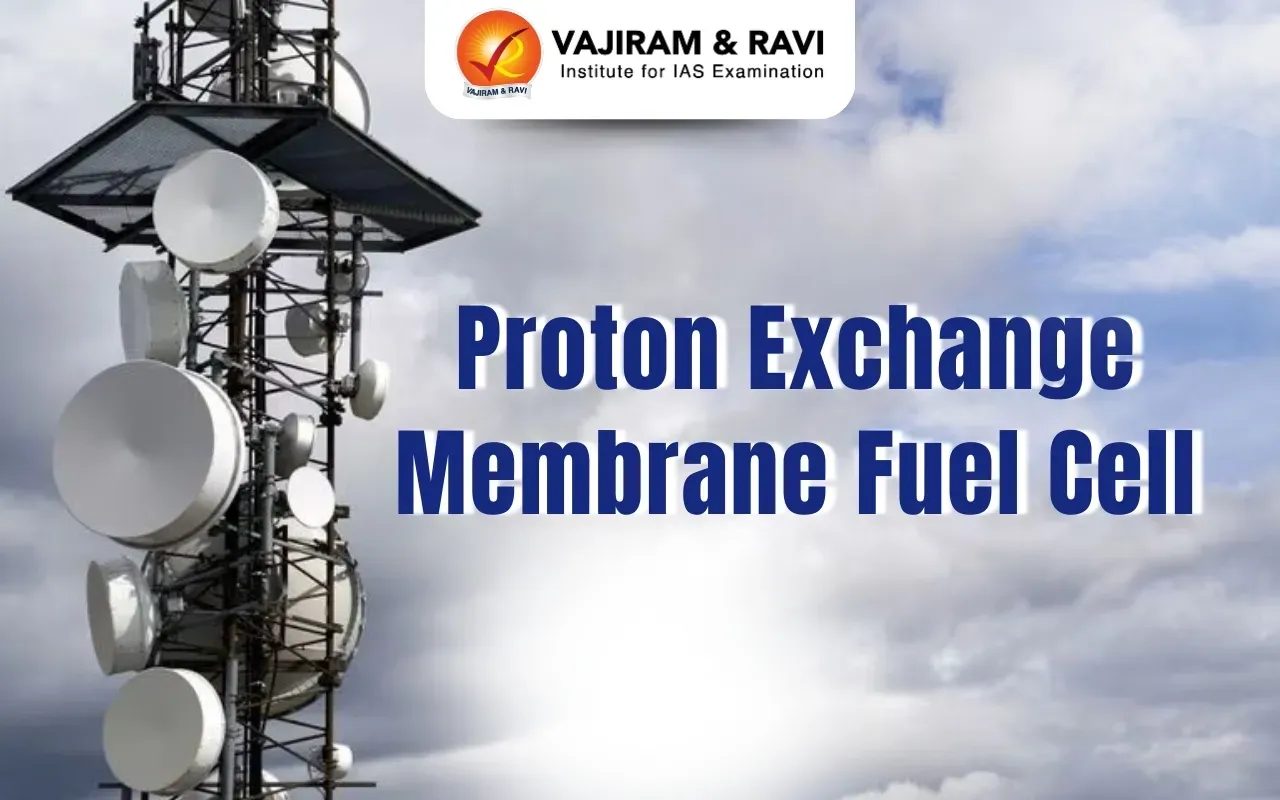Proton Exchange Membrane Fuel Cell Latest News
Recently, the Centre for Fuel Cell Technology (CFCT) at the International Advanced Research Centre for Powder Metallurgy and New Materials showcased a mobile Proton Exchange Membrane fuel cell (PEMFC)-based backup power solution for telecom towers using a plug-and-play model.
About Proton Exchange Membrane Fuel Cell
- It is an electrochemical device that converts the chemical energy of hydrogen and oxygen into electricity through a series of redox reactions.
- Unlike traditional batteries, which store chemical energy internally, PEM fuel cells require a continuous supply of hydrogen fuel and oxygen (typically from the air) to sustain the chemical reaction and generate electricity.
- Working Principle: The working principle involves an electrochemical reaction where hydrogen gas is fed into the anode, oxidized to release protons, which then travel through a polymer membrane to the cathode, where they react with oxygen to produce electricity and water.
- They offer an environmentally friendly solution with high power density in a compact size.
- They run on hydrogen fuel, which can be stored and transported for refuelling, and require significantly less maintenance than traditional backup power sources.
Applications of Proton Exchange Membrane Fuel Cell
- It is an efficient and clean energy solution for powering telecom towers, particularly as a backup during grid outages.
- These fuel cells provide reliable electricity with quick start-up times and operate at relatively low temperatures, making them a viable alternative to diesel generators.
- An innovative hydrogen fuel cell-based backup power solution for telecom towers, developed using a plug-and-play model can support national renewable energy goals while ensuring seamless connectivity for millions and promoting clean energy in the telecom sector.
- Portable power: specific applications include laptops, mobile phones, battery chargers and unmanned aerial vehicles.
Proton Exchange Membrane Fuel Cell FAQs
Q1. What are the applications of PEMFC fuel cells?
Ans. Portable power: specific applications include laptops, mobile phones, battery chargers and unmanned aerial vehicles.
Q2. What is the mechanism of the proton exchange membrane?
Ans. A proton-exchange membrane (PEM) is a polymeric semipermeable membrane that can conduct or transfer cations (protons), at the same time keeping the reactant separate.
Q3. What is an example of a proton exchange membrane?
Ans. One of the most common and commercially available PEM materials is the fluoropolymer (PFSA) Nafion
Source: PIB
Last updated on June, 2025
→ UPSC Notification 2025 was released on 22nd January 2025.
→ UPSC Prelims Result 2025 is out now for the CSE held on 25 May 2025.
→ UPSC Prelims Question Paper 2025 and Unofficial Prelims Answer Key 2025 are available now.
→ UPSC Calendar 2026 is released on 15th May, 2025.
→ The UPSC Vacancy 2025 were released 1129, out of which 979 were for UPSC CSE and remaining 150 are for UPSC IFoS.
→ UPSC Mains 2025 will be conducted on 22nd August 2025.
→ UPSC Prelims 2026 will be conducted on 24th May, 2026 & UPSC Mains 2026 will be conducted on 21st August 2026.
→ The UPSC Selection Process is of 3 stages-Prelims, Mains and Interview.
→ UPSC Result 2024 is released with latest UPSC Marksheet 2024. Check Now!
→ UPSC Toppers List 2024 is released now. Shakti Dubey is UPSC AIR 1 2024 Topper.
→ Also check Best IAS Coaching in Delhi
























